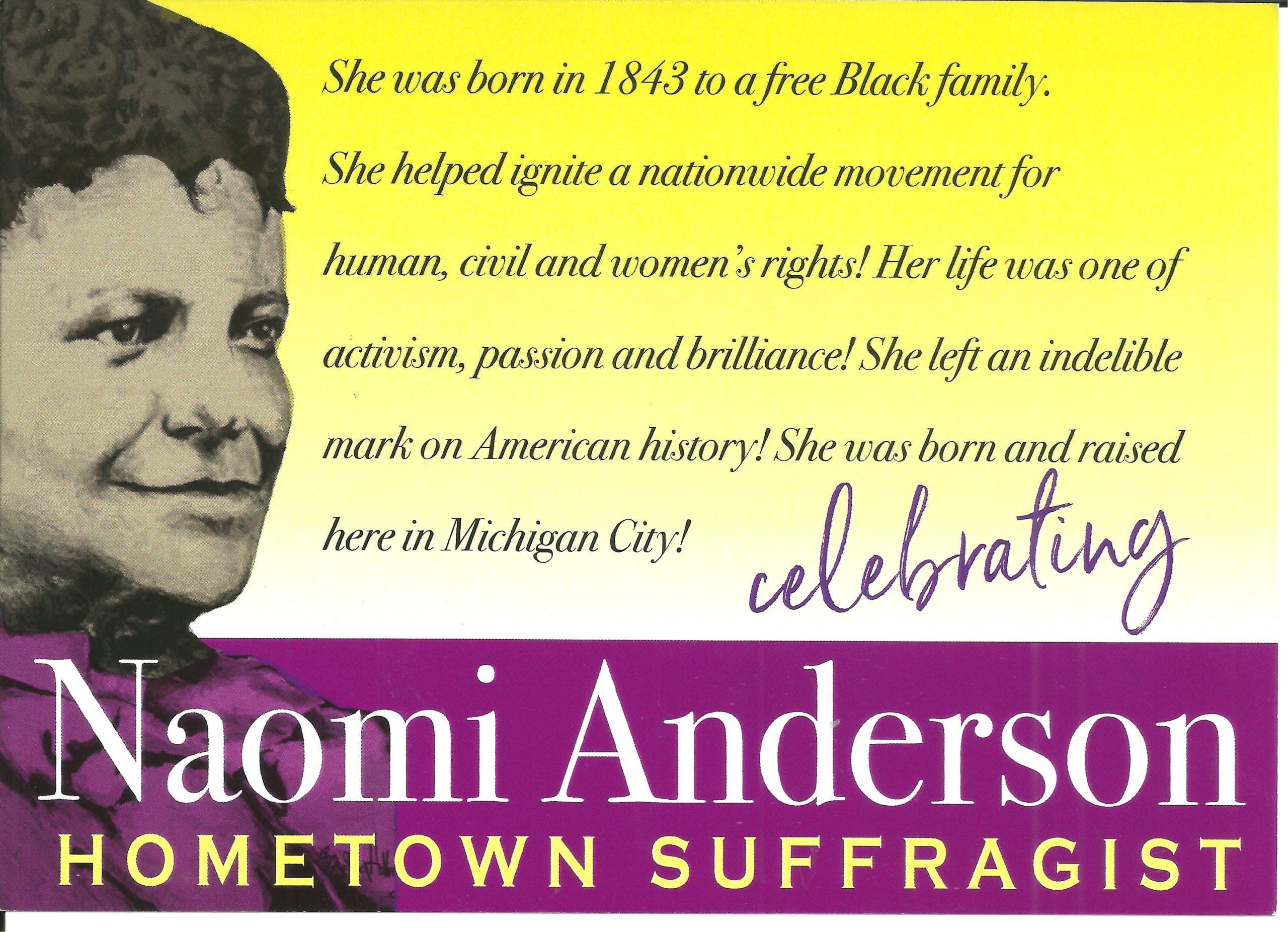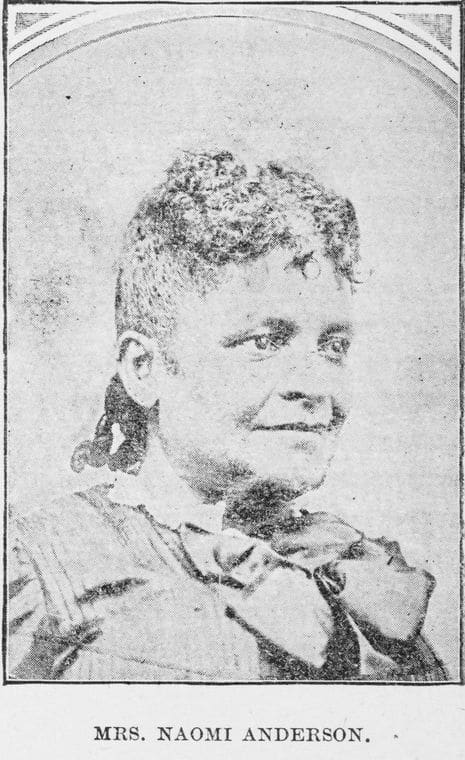
Naomi Anderson: The Eloquent 19th Century Activist
by Bonnie Schaaf (used with permission)

The Life of Naomi Bowman Talbert Anderson
Naomi Bowman Talbert Anderson was born in Michigan City, Indiana in 1843, just seven years after the city was incorporated. She was educated in Michigan City after the public school noted her writing ability and invited her to enroll in the otherwise segregated school. She later credited Michigan City for providing her with an education.
Naomi lived in Michigan City until 1868, at which time she and her husband, William Talbert, moved to Chicago, where she worked for the International Organization of Grand Templars on their temperance campaign. During this period, she wrote about the harsh effects alcohol had on people of color, especially teenagers, because of the harm already done to them by slavery and lack of education. In 1869, Naomi Talbert gave a fiery, controversial speech for women’s suffrage at the first Women’s Rights Conference held in Chicago. The 15th Amendment to the Constitution had just been ratified by Congress giving African American men the right to vote. She advocated for women’s right to vote, stating “What is the difference between a slave and a free man other than the rights one has? And black women have no more rights now than they had before the abolition of slavery.”
This speech was covered in newspapers across the country. In the weeks that followed, she sent copies of it, along with letters to the editors and guest editorials explaining it, to newspapers throughout the United States. This opened the door to having her writings published and her appearances and public activities covered in newspapers for the rest of her life. She was one of the only women, and especially women of color, to have a voice in the nation’s major newspapers in 19th Century America.
In 1869, the Talberts moved to Ohio where Naomi Talbert worked as a hairdresser, raised children, and cared for her husband until his death in 1877. During this time she continued to advocate for temperance and women’s suffrage by lecturing in the mid-west.
In 1881 she married Lewis Anderson, a former slave, and in 1884 they moved to Wichita, Kansas during the black exodus of ex-slaves from the Deep South. In 1895 Naomi Anderson and her family moved to Sacramento, California, and Naomi was the co-lead, along with Susan B. Anthony, of the campaign supporting a California ballot Proposition giving women the right to vote, even headlining above Susan B. Anthony on one occasion. She accomplished all this while confronting the obstacles of a woman of color living in 19th Century America. Naomi Anderson died in 1899 at the age of 56.
The Achievements of Naomi Anderson
Naomi Anderson was fiercely independent, moving around the country, speaking at hundreds of suffrage events. From her first public speech, her eloquent and empowering words acknowledged the need for women’s right to vote. She described the early stages of the suffrage movement in 1869 stating “Miss Anthony and Mrs. Stanton, with their high moral and intellectual power, have shaken the states of New England, and the shock is felt here today. The echo comes back from St. Louis and all through the west; a sensation is aroused in England; and soon the whole world will be awakened to a sense of the value and importance of our cause”.
Mrs. Anderson also worked tirelessly to empower people who lived in a society set up for their suppression. In her speech titled “The Solution to the Race Problem”, she said “We should insist on being called Americans of Color….there should be no German-Americans, Irish-Americans or AfroAmericans. All who were born in this country are Americans. And I, a person of color, have just as much right to claim that as does any white man or woman.”
Mrs. Anderson’s thoughts on segregation coverage of a City Council meeting in “Mrs. Anderson Objects”, Wichita Daily Eagle, 23 December 1893 page 5.
…..I am opposed to separate schools, churches, barber shops or separate anything that makes us a separate people. I do not believe a people amalgamated as we are can be a separate people. We are bone and flesh of every nationality of white men in America, and we have no more right to denounce our white fathers than we have to denounce our black mothers; and we are the sons and daughters of some of the wisest and best men who ever sat in the Legislative halls of this country. Therefore I believe it to be for the best good of my class of people to fight down their color line. It is their indispensible duty to do so; educate their children, fit them for the best position in life, and then watch patiently…we are one people and one nationality.
Coverage of Naomi Anderson co-leading the California suffrage campaign in 1896 with Susan B. Anthony. “Colored Women Suffragists: Mrs. Anderson Leads Her Race in the Fight for the Ballot, Buffalo Evening News August 25, 1896:
The campaign of the woman suffragists still goes merrily on in California. The latest feature of the fight of the women in that State for full franchise is an attempt to stir up the colored women. Mrs. Naomi Anderson has charge of this part of the work. She is a matronly looking colored woman who has been for years identified with the suffragists, and she possesses a natural gift of oratory that has made her work particularly effective in the past and valuable in the present. Mrs. Anderson has interested herself in almost everything that tended toward the advancement of her race and sex. She has helped organize many institutions for the care of colored children and for the education of colored girls, including the colored orphan asylum at Wichita, Kansas. Through her efforts the women’s auxiliary to the G.A.R. was started in Kansas. Her efforts in the present campaign will not only be directed toward arousing interest in the cause among colored women, but she will try to convince the colored men that they should vote for woman suffrage in order to bring their wives and sisters out of political bondage.”
Naomi Anderson’s speech at the Chicago Women’s Rights Convention in 1869 was published in The Revolution, edited by Susan B. Anthony, March 4, 1869. Following is an excerpt from the beginning of the speech.
“A Colored Woman’s Voice.” The Revolution, March 4, 1869, p. 139. The colored women, of all other American women, should be devoted to the cause of Suffrage. One appeared in the recent Chicago Convention to the following effect:
I present myself to you as a composition of humanity, for there flows through my veins a combination of the blood of four distinct nations, of which the greater part is Dutch, part Indian, part African, and the lesser part Irish. I am an American, because here I was born. I am true, because I love the dear old flag. I am on the right side of the question, because I believe woman was made a helpmate for man ; that he is but half a man without woman (applause), and you need her help as well in political affairs as you do in private or domestic affairs. And, gentlemen, I warn you no longer to stand out in refusing the right for which we contend ; in trying to withhold from these noble ladies here and their darker sisters the franchise they now demand…
Naomi Anderson lived a life of activism and eloquence. Yet possibly even more impressive were her civic activism and compassion, shown in newspaper stories that covered her where ever she lived. She founded three orphanages, trained women in business, established a seamstresses’ union to assure fair wages, spoke up at city council meetings. She served as the Kansas state representative to the National American Woman Suffrage Association, and as the representative from her church to the statehouse to fight against school segregation. She fought for educational opportunities for girls, and for food for orphans in Wichita, calling them “God’s little black lambs.”

